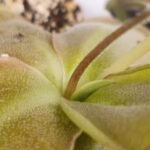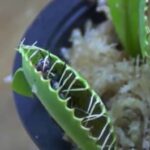As an Amazon Associate, this site earns commissions from qualifying purchases. For more details, click here.
There are many, many sundew variants, but the colors consist primarily of red and green. So what does it mean if your sundew is entirely green? Is that a good or bad sign, or something normal? You are in the right place as this guide explains what an all green drosera means.
Sundews that are completely green do not get enough light. Those that receive sufficient light have red tentacles and lots of dew, which is necessary to catch bugs. Relocating the plant to a sunnier location might help it recover.
Reasons Why Your Sundew is Green
Just like other plants, color is an indicator of health. Sundews should have red or pink tentacles and must be covered in dew, the sticky stuff the plant uses to catch prey.
It is true that some drosera species are mostly green. But even these should have some reddish coloration on the tentacles. All green sundews is indicative of insufficient warmth.
Sundews with red tentacles is a sign of good health. But if the entire plant has turned red it could be a case of too much heat. If this happens and the plant looks sick, check out this guide on why sundews turn red.
What you want is for the tentacles to turn red, not the entire plant. If the tentacles, leaves and everything is green, you have to provide more light.
All green sundews are not only unappealing, but could be dangerous for its well being. If your sundew does not get enough light, it cannot produce dew. The tentacles will either be dry or its dew will consist only of water.
Without dew there is no way sundews can eat prey. Even if you drop a bug into its tentacles, the plant will not eat it.
Sundews depend on light, water and humidity to survive, but nutrients are just important. The nutrition insects provide makes sundews stronger and helps them grow faster. Some variants will even shrink if they are unable to feed.
While some sundews can live with limited nutrients, dew production is still important. Young sundews will not last without getting nutrients from prey. So before you buy a sundew, examine its appearance and make sure it looks healthy.
Fortunately, sundews do not turn green overnight. This happens gradually so you can take steps to remedy the situation.
How to Add More Color to Your Sundews
Seeing your once colorful sundew turn into a drab green can be unsettling. While there should be cause for concern – lack of light is serious for plants – you can fix this.
If your sundew lacks dew and has turned greenish, it needs to be in a light filled environment. The best location is outdoors, or you can keep the plant indoors but on a south facing windowsill. Grow lights also work.
A sick sundew must get at least 8 hours of light per day. If sunlight availability is limited, nurture it indoors with the GE Grow LED Light Bulb. You have to keep the light on for several hours a day to help the plant recover.
If you have not done so already, use the tray method to water sundews. By refilling the tray with water, you keep the plant in a cool and humid environment.
You can tell when sundews have recovered as the tentacles turn red and dew starts appearing. Not only can you see the dew but you can smell it, and the scent is pleasant too.
How long it will take for the sundew to regain its colors depends on its health. Do not expect a quick recovery if the plant has been sick for a while. But with enough light, water and humidity it should be fine.
When you see dew on the tentacles, the plant can start eating again. Its tentacles should be pink or red and ready to catch insects and other prey.
Observe the tentacles for signs of feeding. If it is curled over chances are it has caught something. At least one of these should be closed at all times. if the tentacles remain open but have sticky dew, drop some food into it. Lastly, keep an eye on the temperature in case it gets too hot. If it does, provide some shade for the plant.
What Happens to Sundews if It Stays Green?
Sundews will die without enough light outdoors or indoors, and minimal light is going to weaken them significantly. When the plant tentacles lose their red color and everything has become a pale green, it is a sign of poor health.
If you let sundews turn green, it will slowly die. Without enough light, there is no way the plant can produce the dew necessary to catch insects.
Light is responsible for turning sundew tentacles red. As stated earlier, this is a good sign unless the plant is getting sunburn. Sun burnt sundews have a dried look to them and have crispy leaves, so they are easy to spot.
Just like other plants, sundews need light for energy and fuel. Nutrients from insects are not enough and without light they cannot produce dew anyway.
Water, the right soil mix and humidity are important too, but without sufficient light there is no way sundew will survive. Note that sundews need light, not heat from the sun. If the temperature is above 100 F, sunburn could occur.
The key is to know what colors your sundew variant is supposed to be. Some have more reds than greens, and others the opposite. This is crucial especially if you are growing from seeds. Knowing in advance will help you recognize problems with the plant right away.
The moment you notice the tentacles lose their red color, relocate the container. Give it as much light as possible. Use strong grow lights if yours sundew is a container like the \. If you follow the steps given earlier, your sundew should be able to make a full recovery.
Tips on How to Grow Sundews
The best way to prevent sundews from turning all green is to expose it to light, artificial or natural. However there are other things you can do to keep sundews healthy. These tips apply to Cape Sundews and other species.
- Check for signs of infection. Refusal to eat, deformed leaves, foul smell from the plant or soil are some common signs. This could indicate not just lack of light but also root rot, infestation or bacterial/fungal infection.
- Plant in poor soil. Perlite and sphagnum moss is a popular combination, and you can use peat moss too. The standard mixture is 1:1, but 2:1 and others are acceptable. You can try different ratios when you have enough experience growing these plants.
- Sundews prefer moist conditions and a warm temperature. Sitting the plant in water makes it easier to attain this condition. You can also use a humidifier if necessary.
- Humidity level should be 40–60%. You can do this by putting pebbles under the plant. Place the plant on a saucer filled with water. This will moisten the air to the level sundews prefer.
- Pruning sundews. Prune sundews and move to a new container as the plant grows.
- Feed sundews regularly. This is very important if the plant is at a growing phase. They need to eat once a week to grow. This will also stimulate dew production and help produce more vibrant colors.
- Do not feed processed food to sundews. If you want some variety, give it mealworms or fish food.
- Do not touch the dew. Getting dew on your finger is not a big deal. However, losing dew is crucial for sundews because it is needed to eat prey.
- Be patient. Some drosera species take a long time to close over a prey. Once you drop food onto the plant, leave it. Let the sundew take its time.
Conclusion
If you have been growing sundews for a while, you will notice that colors help you determine its health status. With this guide, you now know what it means if the plant is completely green and what you can do about it.

My fascination with carnivorous plants began many, many years ago with Venus Fly Traps. Now I am more than happy to impart what I know with other enthusiasts and those who are curious about meat eating plants.



